Virginia Airports Where Scheduled Passenger Service Has Been Cancelled

New River Valley Airport (PSK) lost scheduled commercial passenger service in 1972, Hot Springs/Ingalls Field (HSP) in 1993, and Danville Regional Airport (DAN) in 1995
Source: Virginia Department of Aviation, 2016 Virginia Air Transportation System Plan Update - Executive Summary (p.3)
Nine airports in Virginia offer scheduled commercial passenger service today, but airlines have dropped service to four other Virginia airports: New River Valley Airport (PSK), Hot Springs/Ingalls Field (HSP), Danville Regional Airport (DAN), and Lonesome Pine Regional Airport (LPR).
In addition, Piedmont Airlines once proposed to schedule service from Shannon Airport (KEZF) at Fredericksburg.
The Civil Aeronautics Board rejected the Fredericksburg option in 1962. At the time, the Federal government regulated tightly which carriers could offer commercial services at which airports. In the opinion of the Civil Aeronautics Board, roads to existing airports in Northern Virginia and Richmond were good enough for travelers living near Fredericksburg to catch a flight from what was known as National Airport (DCA) in Arlington County and Byrd Field in Richmond (RIC).1
In the same 1962 case, the Civil Aeronautics Board authorized Piedmont Airlines to start passenger and freight service at New River Valley Airport (PSK). That airport was located in Pulaski County, south of the New River. At the time, I-81 had not been built. The Federal agency determined that residents in Blacksburg and Radford lacked sufficient access to what was known as the Roanoke Municipal Airport (ROA), and allowed Piedmont to add New River Valley Airport (PSK) to its schedule.2
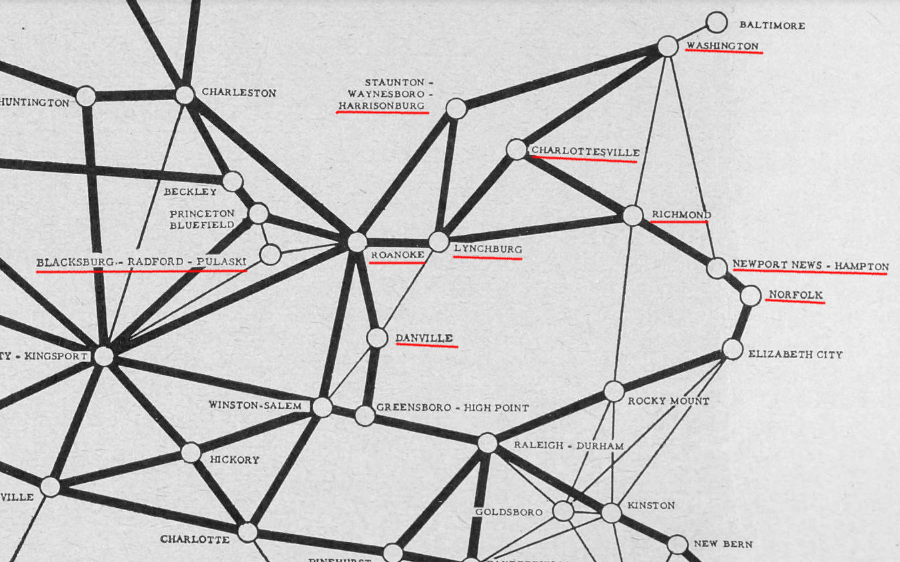
before Piedmont added Hot Springs/Ingalls Field (HSP) in 1964 and Dulles International Airport (IAD) in 1966, it was flying from every Virginia airport with scheduled passenger service
Source: Piedmont Aviation, Piedmont's present and newly authorized routes (1962)
Freight traffic at the New River Valley Airport (PSK) was profitable soon after service started in 1962. Cargo included 2,500 rats/week shipped by air express from Dublin Laboratories to research laboratories. Passenger service was less successful.
By 1972, traffic at the New River Valley Airport (PSK) had dropped from 13 passengers/day to less than 7 passengers/day. Piedmont thought the decline was due to the completion of the 4-lane I-81 highway to Roanoke in 1965, diverting potential passengers. Piedmont's scheduled service to New River Valley Airport (PSK) ended in 1972, when the Civil Aeronautics Board finally approved the petition that had been filed by the airline in 1970.3
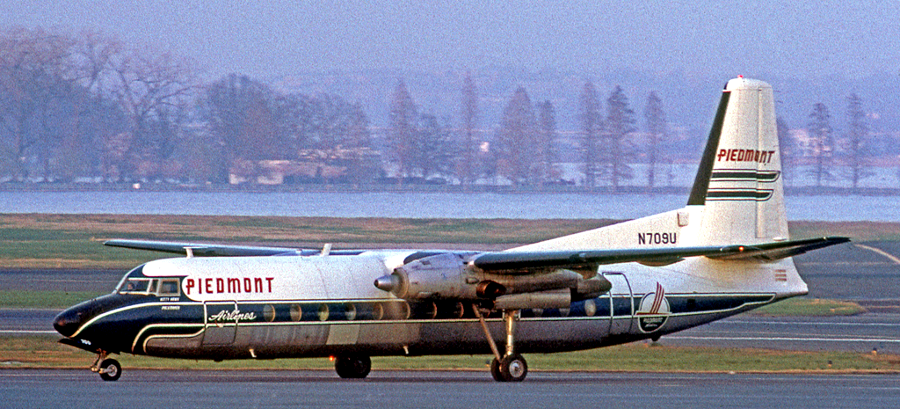
Piedmont Airlines flew turboprops from smaller airports to larger hubs in Northern Virginia, including what is now called Reagan National Airport
Source: Wikipedia, Piedmont Airlines
Piedmont Airlines was granted permission to service Hot Springs/Ingalls Field (HSP) in 1964. Hot Springs became an intermediate hop between Staunton and Lynchburg, and was the last Virginia airport to get scheduled passenger service.
Two airlines had sought authority from the Civil Aeronautics Board to fly into Hot Springs, anticipating profits from travelers going to the Homestead Resort. The Federal government authorized the addition of service after finding:4
- Hot Springs, in the heart of a very mountainous area, is comparatively isolated from its major travel markets; that available surface transportation is extremely circuitous, time-consuming, unresponsive to the business needs of the area;, and of limited utility to the tourist and recreational traffic attracted to Hot Springs.
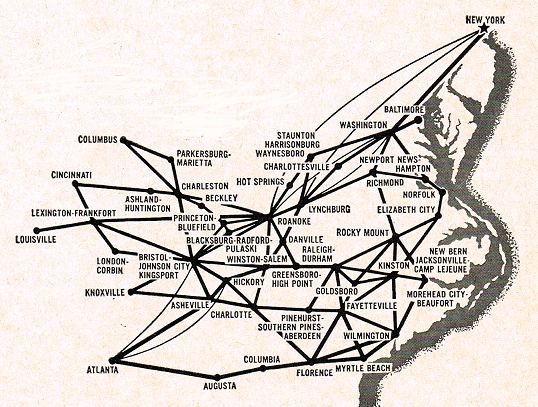
in 1966 travelers could catch a flight in Pulaski, or at Hot Springs in Bath county, and go to New York City
Source: DepartedFlights.com, Piedmont Airlines Pus New York City on the Map (1966)
Ingalls Field was at an elevation higher than any other east of the Mississippi River with scheduled service, and winter weather (especially fog) was a significant constraint. In 1967 the internal airline newsletter included this reference to rebooking passengers on Chesapeake and Ohio (C&)) Railroad trains due to weather-caused cancellation of flights at the airport:5
- Before going up on Warm Springs Hill
- I take a tranquiling pill
- That's the way it is and always shall be.
- When I finally make it to the top
- My wheels fall off - my motor's hot
- That's the way it is and always shall be.
- I tried to catch a Piedmont plane
- And ended up on a C&O train
- That's the way it is and always shall be
- That's the way it is and always shall be.
In 1975 Piedmont shifted to seasonal service and stopped operating in December-March. Scheduled passenger flights to Hot Springs/Ingalls Field (HSP) ended in 1993.
Today, General Aviation pilots are warned to look out for bears near the runway on the Warm Springs Mountain ridge. The airport tried to convert its harsh conditions into an advantage, advertising its suitability for testing aircraft because it has an aircraft carrier-type runway and:6
- wind shear frequently occurs at the airport when wind hits the side of the mountain and rides up one side and goes down on the other
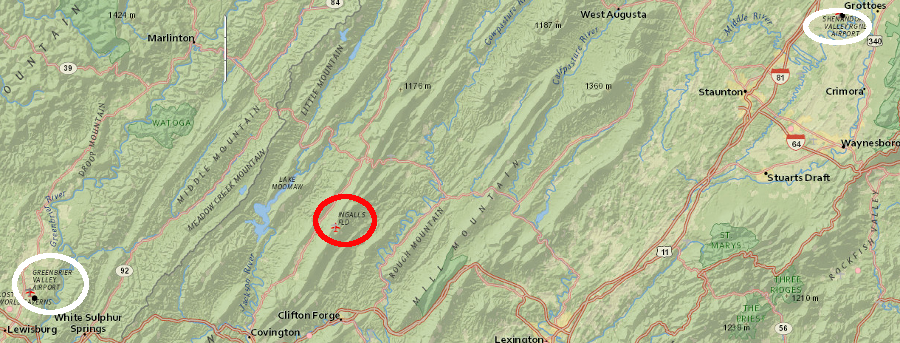
in Highland, Bath, and Allegheny counties, customers who once flew out of Hot Springs/Ingalls Field (HSP) must now drive to Greenbrier Valley Airport (LWB) or Shenandoah Valley Regional Airport (SHD)
Source: ESRI, ArcGIS Online
Danville was the last Virginia city to lose commercial air service, in 1995. Piedmont Airlines, which started service there in 1948, pulled out in 1979.7
Danville lacked the population base to generate enough business to maintain flights to Charlotte and Winston-Salem, as airlines shifted to a spoke-and-hub system. There were only 100,000 residents in the city and surrounding Pittsylvania County in 2015, and the nearest competing airport in Greensboro, North Carolina was just 40 miles away.
In 2016, the Greyhound bus company also stopped servicing Danville due to low ridership. Customers were advised to catch the bus in Greensboro.8

Danville lost its scheduled passenger service to Greensboro's airport, less than 50 miles away
Source: VFR MAP
New River Valley Airport (PSK), Hot Springs/Ingalls Field (HSP), and Danville Regional Airport (DAN) remain operational, serving as General Aviation airports now. Air Force One with President Clinton (a DC-9) did land at Ingalls Field when visiting Hot Springs in 2000.9
Since deregulation of the airline industry in 1978, airlines have had great flexibility in altering flight schedules and airports they service. The Civil Aeronautics Board and, after 1985, the US Department of Transportation have administered an Essential Air Service program to subsidize small airports and ensure communities retain scheduled passenger service.
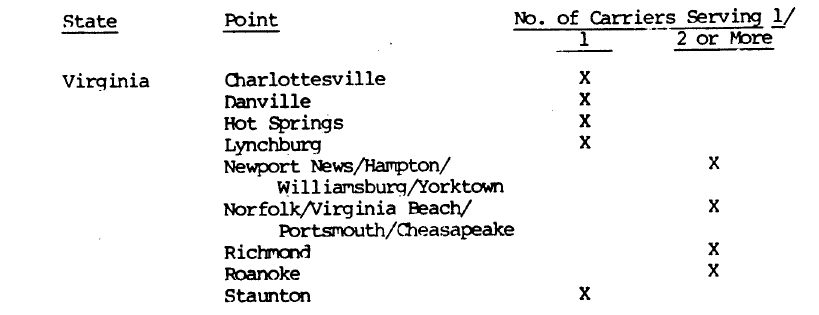

despite being listed in 1978 as eligible for the Essential Air Service program, Hot Springs and Danville both lost scheduled passenger service due to excessive costs - and service was not restarted at New River Valley Airport (PSK)
Source: US Department of Transportation, Original List of EAS Eligible Communities (p.18, Table 4-p.5)
In 2015 the Bureau of Census estimated there were 1.3 million Virginians living west of the Blue Ridge, and the large urban center was at Roanoke. Over 250,000 people lived in the counties of Augusta and Rockingham, plus the cities of Harrisonburg, Staunton, and Waynesboro, but demand for commercial service at Shenandoah Valley Regional Airport (SHD) was too low to retain the business of a commercial carrier.
The Shenandoah Valley Regional Airport (SHD) retains scheduled passenger service only because the airline servicing that location receives an Essential Air Service subsidy from the Federal government. Scheduled passenger service is offered by for-profit airline companies, and they would stop servicing Shenandoah Valley Regional Airport if the subsidy was withdrawn.
Danville and Hot Springs also relied upon Essential Air Service funding to maintain commercial operations until the subsidy exceeded $200 per passenger. Since neither airport was more than 210 miles from a medium or large hub, the US Department of Transportation eliminated the special Federal funding for those airports.10
Differences in local topography help explain why the US Department of Transportation provides Essential Air Service funding for the Shenandoah Valley Regional Airport (SHD), but will not do the same at Danville Regional Airport (DAN).
The drive from Danville to the Piedmont Triad International Airport (PTI) in Greensboro, and the drive from Shenandoah Valley Regional Airport (SHD) to Charlottesville-Albemarle (CHO), are both about 55 miles. However, the Danville-Greensboro drive on US29 is easy compared to driving US33 or I-64 across the mountains from the Shenandoah Valley to Charlottesville. The Shenandoah Valley is isolated by the Blue Ridge, and even the interstate highway crossing at Afton Gap can be hazardous.
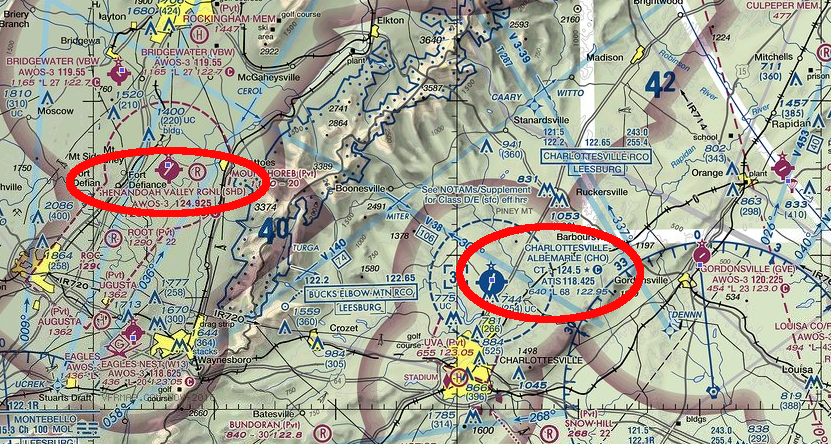
the barrier of the Blue Ridge helps justify the continued Essential Air Service subsidy for Shenandoah Valley Regional Airport (SHD)
Source: VFR MAP
Appalachian Airlines once provided commercial passenger service between Lonesome Pine Regional Airport (LPR) in Wise County and Tri-Cities Regional Airport (TRI) serving Bristol, Kingsport, and Johnson City, Tennessee. That service operated in the late 1970's. Since then, the airport has been used by general aviation flights, including med-evac flights and helicopters from which utility company inspectors can verify the condition of electricity transmission lines crossing the rugged mountains.11
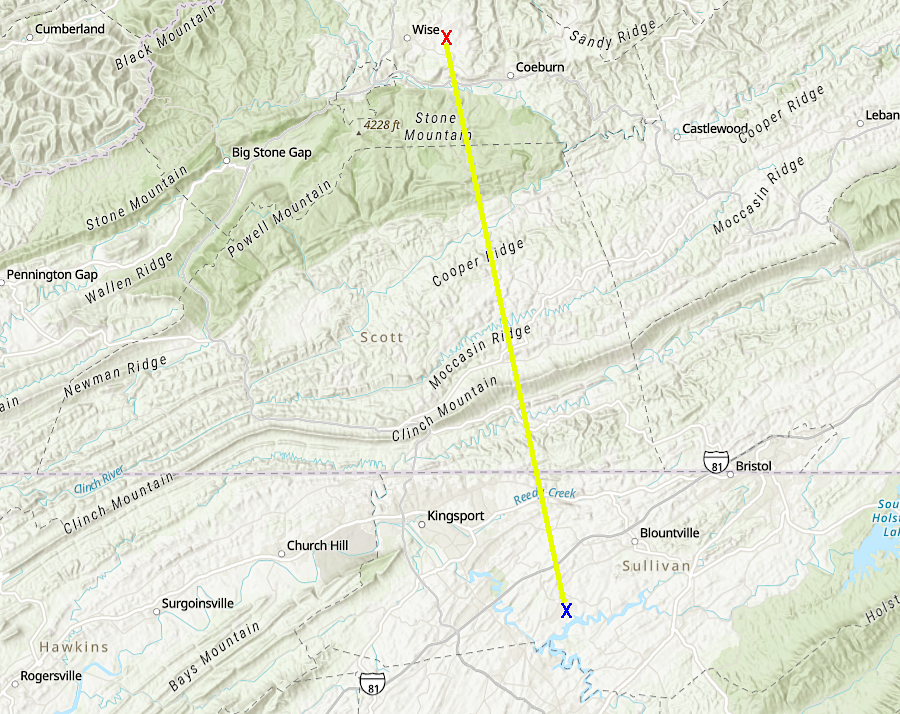
Appalachian Airlines once flew between Lone Pine Regional Airport (LPR - red X) and Tri-Cities Regional Airport (TRI - blue X)
Source: ESRI, ArcGIS Online
Links
References
1. "CAB Announces Decision on Piedmont Area Case," Piedmonitor, Piedmont Aviation, February-March 1962, p.1, http://newspapers.digitalnc.org/lccn/2014236866/1962-02-01/ed-1/seq-1/ (last checked December 30, 2016)
2. "CAB Announces Decision on Piedmont Area Case," Piedmonitor, Piedmont Aviation, February-March 1962, p.1, http://newspapers.digitalnc.org/lccn/2014236866/1962-02-01/ed-1/seq-1/ (last checked December 30, 2016)
3. "NRV Airport Dedicated, Called 'Fine Example,'" Piedmonitor, Piedmont Aviation, June 1962, http://newspapers.digitalnc.org/lccn/2014236866/1962-06-01/ed-1/seq-1/; "It's a Great Place for 'Go-Getters,'" Piedmonitor, Piedmont Aviation, April 1963, http://newspapers.digitalnc.org/lccn/2014236866/1963-04-01/ed-1/seq-3/; "Piedmont Requests Board to Delete Some Service," Piedmonitor, Piedmont Aviation, July 1970, http://newspapers.digitalnc.org/lccn/2014236866/1970-07-01/ed-1/seq-1/; "Board Allows Deletion," Piedmonitor, Piedmont Aviation, February, 1972, http://newspapers.digitalnc.org/lccn/2014236866/1972-02-01/ed-1/seq-4/ (last checked December 30, 2016)
4. "CAB Authorizes Hot Springs Service," Piedmonitor, Piedmont Aviation, March 1964, p.1, http://newspapers.digitalnc.org/lccn/2014236866/1964-03-01/ed-1/seq-1/ (last checked December 30, 2016)
5. "Piedmont Press Notes," Piedmonitor, Piedmont Aviation, August 1967, p.4, http://newspapers.digitalnc.org/lccn/2014236866/1967-08-01/ed-1/seq-4/; "Ingalls Field Airport," http://www.ingallsfield.com/ (last checked December 30, 2016)
6. "HSP Reopens in April," Piedmonitor, Piedmont Aviation, December 1975/January 1976, p.5, http://newspapers.digitalnc.org/lccn/2014236866/1975-12-01/ed-1/seq-5/; "Ingalls Field Airport," AirNav.com, http://airnav.com/airport/hsp; "Ingalls Field Airport," http://www.ingallsfield.com/ (last checked December 30, 2016)
7. "Chronology of Inaugural Service," Piedmont Airlines, http://www.jetpiedmont.com/inaugural/
(last checked December 31, 2016)
8. "Why No Commercial Flights To DAN (Danville, VA)?," Airliners.net blog, May 3, 2011, http://www.airliners.net/aviation-forums/general_aviation/read.main/5133709/; "'Very low ridership' forces Greyhound out of Danville," Danville Register & Bee, April 19, 2016, http://www.godanriver.com/news/danville/very-low-ridership-forces-greyhound-out-of-danville/article_14711280-066d-11e6-9351-6756b621b664.html; "Annual Estimates of the Resident Population: April 1, 2010 to July 1, 2015," American Fact Finder, Bureau of Census, http://factfinder.census.gov/faces/tableservices/jsf/pages/productview.xhtml?pid=PEP_2015_PEPANNRES&src=pt (last checked June 20, 2016)
9. "Ingalls Field Airport," http://www.ingallsfield.com/ (last checked December 30, 2016)
10. "Annual Estimates of the Resident Population: April 1, 2010 to July 1, 2015," American Fact Finder, Bureau of Census, http://factfinder.census.gov/faces/tableservices/jsf/pages/productview.xhtml?pid=PEP_2015_PEPANNRES&src=pt; "What Is Essential Air Service (EAS)?," Office of Aviation Analysis, US Department of Transportation, April 1, 2009, p.3, https://www.transportation.gov/sites/dot.dev/files/docs/easwhat.pdf (last checked June 20, 2016)
11. "A brighter future for rural airports?," Cardinal News, December 9, 2021,, https://cardinalnews.org/2021/12/09/a-brighter-future-for-rural-airports/ (last checked December 9, 2021)
Transportation: From Feet to Teleports
Virginia Places









